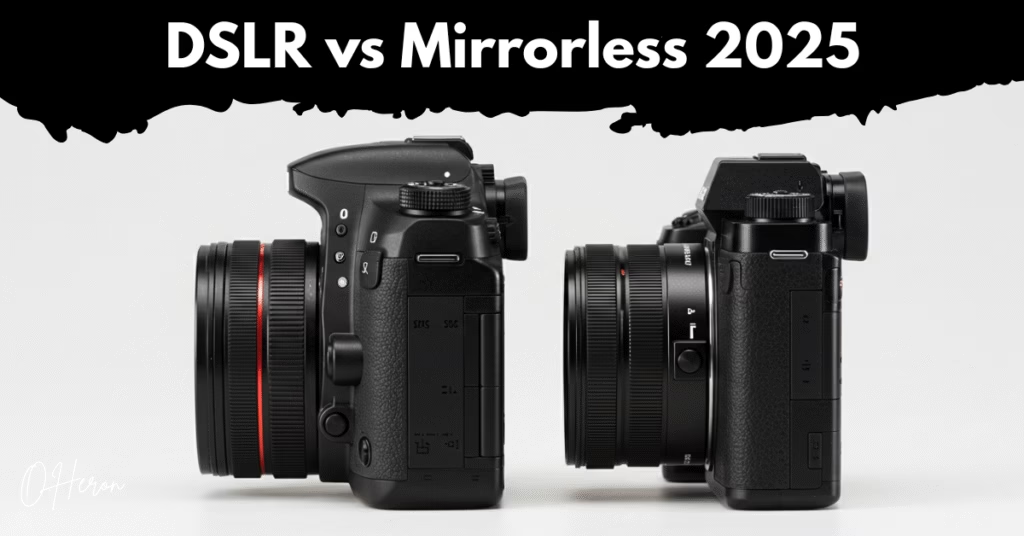The photography world has dramatically shifted toward mirrorless cameras, but DSLRs still have their place. As a new photographer in 2025, understanding the differences will help you make the right choice for your needs, budget, and shooting style. This comprehensive guide breaks down everything you need to know to make an informed decision.
Understanding the Core Technology Differences
How DSLRs Work
DSLRs (Digital Single-Lens Reflex cameras) use a mirror mechanism that flips up when you take a photo, allowing light to hit the sensor. When you look through the viewfinder, you’re seeing the actual scene through an optical viewfinder that shows exactly what the lens sees without any electronic processing.
Key DSLR Components:
- Reflex mirror that flips up during exposure
- Optical viewfinder with pentaprism or pentamirror
- Separate autofocus sensor system
- Traditional mechanical shutter
How Mirrorless Cameras Work
Mirrorless cameras use a relatively newer technology that has steadily improved over the last decade. Unlike traditional DSLRs, they don’t have a reflex mirror or optical viewfinder. Instead, light passes straight through the lens onto the image sensor. You compose your shots using either an electronic viewfinder (EVF) or the rear LCD screen, both showing a digital representation of your scene.
Key Mirrorless Components:
- No mirror mechanism – direct light path to sensor
- Electronic viewfinder (EVF) or LCD screen
- On-sensor phase detection autofocus
- Electronic or mechanical shutter options
Size and Weight: The Portability Factor
Mirrorless Advantages
Mirrorless cameras are generally more compact and lightweight because they don’t need the mirror box and prism that give DSLRs their bulk. This makes them appealing for anyone who spends long hours with a camera in hand—or on their back.
Real-World Weight Comparisons:
- Sony A7 IV (mirrorless): 658g body only
- Canon EOS R6 Mark II (mirrorless): 588g body only
- Canon EOS 90D (DSLR): 701g body only
- Nikon D780 (DSLR): 840g body only
The Lens Factor
While mirrorless camera bodies are lighter, the total system weight depends heavily on lens choice. Some considerations:
Mirrorless Lens Benefits:
- Native lenses designed for shorter flange distance
- Often smaller and lighter than DSLR equivalents
- Modern optical designs with better performance
DSLR Lens Reality:
- Larger, heavier lenses can negate body weight savings
- Extensive selection of used lenses available
- Some professional telephoto lenses are similar weight regardless of system
Travel and Comfort Impact
After a full day of shooting, weight differences become significant. If you have ever spent a long, hot day of landscape photography trekking with your DSLR, trifecta of lenses, you’ll appreciate the reduced fatigue that comes with a lighter mirrorless system.
Performance Comparison: Where Each System Excels

Autofocus Performance
Performance-wise, mirrorless cameras often deliver faster continuous shooting speeds and more sophisticated autofocus tracking, which can be critical for sports and wildlife photography. Moreover, the ability to shoot silently in mirrorless systems opens up new creative opportunities
Mirrorless Autofocus Advantages:
- On-sensor phase detection across the entire frame
- Real-time eye detection for humans, animals, and birds
- Superior video autofocus performance
- Silent shooting modes for discrete photography
DSLR Autofocus Characteristics:
- Proven reliability in challenging conditions
- Excellent battery-powered performance
- Predictable behavior that professionals trust
- Superior performance with certain telephoto lenses
Battery Life: A Critical Consideration
DSLR Battery Champions:
- 600-1,200 shots per charge typical
- Optical viewfinder uses no power when composing
- Can last weeks in standby mode
- Better cold weather performance
Mirrorless Battery Reality:
- 300-500 shots per charge (improving in newer models)
- Electronic viewfinder constantly drains power
- Most photographers carry 2-3 spare batteries
- USB-C charging available in modern cameras
Battery Management Tips:
- Use power-saving modes to extend life
- Turn off Wi-Fi when not needed
- Consider external battery packs for video work
- Cold weather significantly reduces performance
Image Quality: The Great Equalizer
The truth is, both DSLRs and mirrorless cameras can use identical sensors. Mirrorless cameras offer similar image quality and functionality to DSLR cameras, making them a popular choice for photographers who want a more portable yet powerful camera. Image quality differences come from:
Sensor Technology
- Both systems use the same sensor manufacturers (Sony, Canon, etc.)
- Full-frame sensors perform identically regardless of camera type
- APS-C and other crop sensors also perform similarly
Image Processing
- Mirrorless cameras often have newer, more powerful processors
- Better computational photography features
- More advanced noise reduction algorithms
- Superior video processing capabilities
Lens Performance
- Mirrorless-native lenses often outperform adapted DSLR lenses
- Shorter flange distance allows for better optical designs
- Both systems have access to excellent professional glass
Lens Ecosystems: Building Your Kit
DSLR Lens Advantages
Mature Systems:
- Decades of lens development and refinement
- Extensive used lens market with great values
- More third-party options from Sigma, Tamron, and others
- Price range from budget to professional levels
Proven Performance:
- Professional telephoto lenses with excellent track records
- Specialized lenses for every conceivable need
- Compatibility across multiple camera generations
Mirrorless Lens Evolution
Modern Optical Design:
- Lenses designed specifically for mirrorless systems
- Often superior optical quality due to modern design
- Typically lighter and more compact
- Advanced features like focus-by-wire systems
Growing Selection:
- Major lens gaps have been filled by 2025
- All manufacturers investing heavily in mirrorless glass
- Innovation happening primarily in mirrorless space
Adaptation Options
Using DSLR Lenses on Mirrorless:
- High-quality adapters maintain autofocus performance
- Access to massive DSLR lens library
- Some adapters add image stabilization
- Negates size and weight advantages
Cost Considerations:
- Quality adapters cost $100-400
- Native lenses generally more expensive than DSLR equivalents
- Used mirrorless lens market still developing
Usability and Learning Experience
DSLR Learning Benefits
Traditional Approach:
- Optical viewfinder shows the actual scene
- Physical dials and buttons for major settings
- Familiar interface consistent across brands
- No electronic lag or delay
Reliability Factors:
- All-day battery life reduces anxiety
- Proven durability in harsh conditions
- Simpler menu systems in many cases
- Less dependent on electronic systems
Mirrorless Learning Advantages
Educational Features:
- See exposure changes in real-time through EVF
- Focus peaking and magnification aid manual focusing
- Histogram and exposure information overlay
- Instant review of captured images
Modern Conveniences:
- Customizable interface and button layouts
- Silent shooting modes
- Advanced video features built-in
- Smartphone connectivity for sharing and control
Cost Analysis: Initial Investment and Long-Term Value
Entry-Level Comparison (2025 Prices)
DSLR Options:
- Canon EOS Rebel T7i + 18-55mm: ~$600
- Nikon D3500 + 18-55mm: ~$500
- Extensive used market options: $200-400
Mirrorless Options:
- Sony A6000 + 16-50mm: ~$550
- Canon EOS M50 Mark II + 15-45mm: ~$600
- Fujifilm X-T30 II + 18-55mm: ~$900
Professional-Level Investment
High-End DSLRs:
- Canon EOS 5D Mark IV: ~$2,500
- Nikon D850: ~$2,800
- Proven professional tools with established workflows
Professional Mirrorless:
- Sony A7R V: ~$3,900
- Canon EOS R5: ~$3,900
- Cutting-edge technology and features
Long-Term Value Considerations
- DSLR development has essentially stopped at most manufacturers
- Almost all major manufacturers having refocused their efforts to mirrorless systems
- Mirrorless systems will receive continued development and support
- Used DSLR values remain stable due to proven performance
Video Capabilities: A Clear Winner
Mirrorless Video Advantages
Superior Video Features:
- 4K recording standard across most models
- Advanced autofocus during video recording
- Silent shooting modes for video work
- Better electronic stabilization systems
- Flip screens for selfie-style recording
Professional Video Tools:
- Log profiles for color grading
- Higher bit-rate recording options
- Better low-light video performance
- External microphone inputs standard
DSLR Video Limitations
Basic Video Functions:
- Often limited to 1080p recording
- Poor autofocus during video recording
- Limited video-specific features
- Designed primarily for still photography
Future-Proofing Your Investment
The Industry Trend
But in 2025, the manufacturers have worked out most of the bugs, to the point where the mirrorless full-frame camera models are just as good, if not better, than your favourite DSLR.
Mirrorless Development:
- All major innovations happening in mirrorless space
- Computational photography advancement
- AI-powered features and improvements
- Continued lens ecosystem expansion
DSLR Reality:
- Most manufacturers have stopped new DSLR development
- Existing cameras will continue to receive support
- Excellent used market values
- Still capable of professional results
Making Your Decision: A Framework
Choose DSLR If You:
- Have a limited budget and need access to affordable lenses
- Shoot primarily sports or wildlife with long telephoto lenses
- Value all-day battery life above all other factors
- Prefer optical viewfinders and traditional camera operation
- Already own compatible lenses from previous cameras
- Don’t plan to shoot video regularly
Choose Mirrorless If You:
- Prioritize portability and reduced weight
- Shoot both photos and video regularly
- Want access to the latest camera technology and features
- Value silent shooting capabilities
- Plan to invest in a camera system for years to come
- Appreciate modern conveniences like Wi-Fi and smartphone integration
- Shoot in varied lighting conditions where EVF preview helps
Budget-Conscious Recommendations
Best Value DSLR Route:
- Buy used DSLR body + quality used lenses
- Focus budget on glass rather than latest camera features
- Excellent image quality at fraction of new price
Budget Mirrorless Strategy:
- Start with entry-level mirrorless + kit lens
- Add one quality prime lens (35mm or 50mm equivalent)
- Plan lens purchases around developing interests
The 2025 Reality Check
Right now, there’s never been more choice – but for most photographers, mirrorless makes the most sense. The technology has matured to the point where the traditional advantages of DSLRs (battery life, lens selection, price) are less significant than they were even a few years ago.
For Absolute Beginners
If you’re just starting photography and don’t have existing equipment, mirrorless represents the better long-term investment. The learning benefits of real-time exposure preview, focus aids, and modern features outweigh the traditional advantages of DSLRs.
For Upgraders
If you already own DSLR lenses, the decision becomes more complex. Consider:
- Adapters allow you to use existing lenses on mirrorless bodies
- Gradual transition is possible
- Evaluate whether the benefits justify the switching cost
Professional Considerations
Both systems are capable of professional results. Your choice should be based on:
- Specific workflow requirements
- Client needs and delivery expectations
- Personal preference and comfort
- Long-term business planning
Conclusion: The Path Forward
The mirrorless vs DSLR debate in 2025 isn’t about which produces better images—both are capable of exceptional results. It’s about which system better fits your photography goals, physical needs, and budget constraints.
For most new photographers, mirrorless cameras offer a better combination of modern features, learning aids, future-proofing, and portability. However, DSLRs remain excellent choices for budget-conscious photographers, those with specific professional needs, or photographers who simply prefer the traditional camera experience.
The most important factor is choosing a camera that encourages you to shoot more often. Whether that’s a lightweight mirrorless camera that’s easy to carry or a substantial DSLR that feels professional in your hands, the best camera is the one you’ll actually use.
Consider visiting a camera store to handle both types, or rent different systems for a weekend to see which feels more natural. Your personal connection with the camera will ultimately be more important than any specification comparison.
